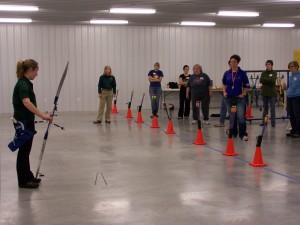
Betsy Bacon, a Michigan State University student studying art history, draws the bowstring of a recurve bow at a Becoming an Outdoors-Woman archery workship in Februrary 2010. Photo: C. Thompson
By Carol Thompson
Twelve women line up, bows in hand. At the chirp of a whistle, they pick up their arrows, draw their bowstrings, and hit their targets with loud thwacks.
These budding archers are learning new skills thanks to an outreach program designed to foster a love of outdoor recreational activities in women.
More than 20,000 women attend Becoming an Outdoors-Woman activities each year.
The program has spread to 43 states, six Canadian provinces and even New Zealand, says Peggy Farrell, director of International Becoming an Outdoors-Woman.
The initiative to get more women engaged in the environment originated at a University of Wisconsin Stevens Point academic conference in 1990, when natural resource management professors and professionals discussed what kept women from the outdoors.
Half of the reasons they came up with had to do with level of education.
The professionals established the Becoming an Outdoors-Woman program in 1991 to break down barriers that kept women from participating in things like target shooting and fishing.
The program helps women cultivate a greater awareness of conservation issues and a better understanding of resource management practices, Farrell says.
In 1995, former Becoming an Outdoors-Woman Director Diane Lueck researched the attitudes and activities of the organization’s participants and found that women who had attended BOW workshops were significantly more aware of conservation and environmental issues.
Ten years later, Farrell expanded this research into workshops geared toward female farmers. The goal was to inform them about sustainable land-management practices.
Nearly three-quarters of female farmers felt more environmentally aware and better able to manage their land, according to a post-workshop survey.
Becoming an Outdoors-Woman activities focus on teaching women skills that will help them enjoy outdoor recreation, like kayaking, hunting and showshoeing, but Farrell makes sure that the content also emphasizes environmental ethics.

Cara Easterbrook, Michigan State University archery club president, demonstrates using a competitive recurve bow at the university's Demmer Center.
Participants learn about conservation groups like Ducks Unlimited that focus on habitat protection and how recreation impacts the environment.
The workshops are designed for novice skill levels and broken into categories such as hunting and shooting, fishing and a variety of other activities. Classes vary by geographic region, and focus on what women really want to learn.
Michigan women want to learn how to shoot handguns.
“Women and handguns right now, they’re really going for it,” says Sue Tabor, the Michigan program’s coordinator. “Some women are thinking about personal protection. An intro class gives them a chance to see if they like handling and shooting a handgun. Some women just love target shooting.”
Shooting is so popular in Michigan that Tabor had to increase the price of handgun classes to cover ammunition costs.
The program isn’t meant to make a profit – making money is actually discouraged on the national level. The registration fees for workshops and funds from state hunting and fishing license fees pay for the program, so it hasn’t been affected by Michigan’s bad economy.
Prices for weekend classes range from $150 to $350, depending on the facilities and classes offered. Some states, like Michigan, offer single classes that cost between $10 and $25.
Popular classes include archery, kayaking and fishing. Some workshops are designed to teach women how to handle tasks like backing up a trailer. After a trailer-backing class, women can help their husbands with the vehicles instead of standing aside and watching, Tabor says.
“I think BOW probably saves a lot of marriages,” she says.
Most of the women involved in Becoming an Outdoors-Woman workshops are in their 40s. Tabor attributes that to some women’s desires to spend more time with their husbands.
When Tabor works at booths to advertise the program, she says a lot of husbands ask about getting their wives involved with the program. Husbands may want their wives to go with them on hunting and fishing trips, but they aren’t always the best teachers, she says.
“The women really like the atmosphere of learning with other women,” Tabor says. “We’re kind of our own best cheerleaders. Women have a way of encouraging each other.”
When Betsy Bacon, a student of art history at Michigan State University, attended her first archery workshop in February, it was her first time using a bow and arrow.
Bacon doesn’t consider herself an “outdoorsy” person. She was nervous until she saw that first arrow fly from the bowstring.
“There’s that moment of relief,” Bacon said. “It’s encouraging. Until you try, you don’t know how easy it is.”
Bacon felt comfortable and less pressured in the all-female environment.
For Tabor, building confidence in women is a huge benefit of the program. As soon as women try new things, especially shooting firearms, the feeling of victory shows on their faces, she says.
“Instantly, they’re no longer afraid,” Tabor says. “And they turn around and they look at me and say ‘can I do that again?’ I just know you’re more confident when you try these things.”
Becoming an Outdoors-Woman isn’t the only program with a environmental focus geared towards women. The National Wild Turkey Federation’s Women in the Outdoors is a nonprofit conservation and hunting organization that targets women 14 and older.
The Becoming an Outdoors-Woman program has found its niche in adult education.
“Adult women make sure everybody else is taken care of, and if there’s any time, money or energy left, they do it for themselves,” Farrell says. “The confidence and self-esteem building, and the fact that they do something just for themselves turns out to be something that’s a hallmark of the program.”
